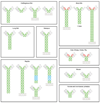The function and regulation of immunoglobulin D
- PMID: 21353515
- PMCID: PMC3109135
- DOI: 10.1016/j.coi.2011.01.006
The function and regulation of immunoglobulin D
Abstract
Recent discoveries of IgD in ancient vertebrates suggest that IgD has been preserved in evolution from fish to human for important immunological functions. A non-canonical form of class switching from IgM to IgD occurs in the human upper respiratory mucosa to generate IgD-secreting B cells that bind respiratory bacteria and their products. In addition to enhancing mucosal immunity, IgD class-switched B cells enter the circulation to 'arm' basophils and other innate immune cells with secreted IgD. Although the nature of the IgD receptor remains elusive, cross-linking of IgD on basophils stimulates release of immunoactivating, proinflammatory and antimicrobial mediators. This pathway is dysregulated in autoinflammatory disorders such as hyper-IgD syndrome, indicating that IgD orchestrates an ancestral surveillance system at the interface between immunity and inflammation.
Copyright © 2011 Elsevier Ltd. All rights reserved.
Figures


References
-
- Finkelman FD, van Boxel JA, Asofsky R, Paul WE. Cell membrane IgD: demonstration of IgD on human lymphocytes by enzyme-catalyzed iodination and comparison with cell surface Ig of mouse, guinea pig, and rabbit. J. Immunol. 1976;116:1173–1181. - PubMed
-
- Ruddick JH, Leslie GA. Structure and biologic functions of human IgD. XI. Identification and ontogeny of a rat lymphocyte immunoglobulin having antigenic cross-reactivity with human IgD. J. Immunol. 1977;118:1025–1031. - PubMed
-
- Finkelman FD, Woods VL, Berning A, Scher I. Demonstration of mouse serum IgD. J. Immunol. 1979;123:1253–1259. - PubMed
Publication types
MeSH terms
Substances
Grants and funding
LinkOut - more resources
Full Text Sources

